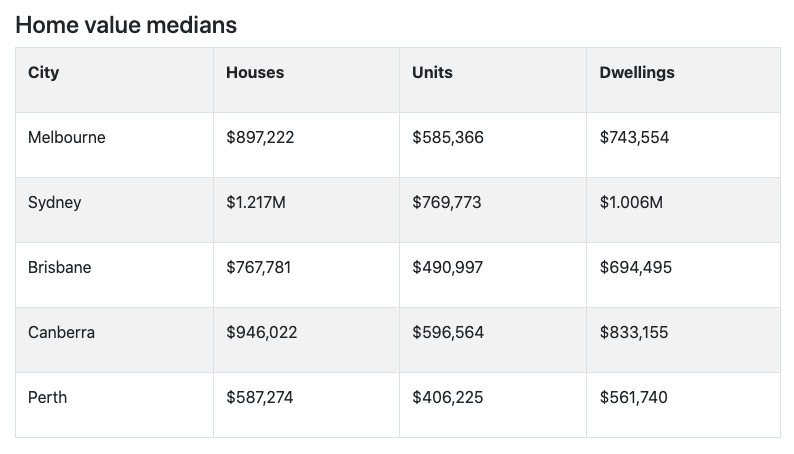
The year in property has begun with some stabilisation in values
Australian property values appeared to stabilise with a 0.1% increase in national dwelling values for February. There was a –2.3% drop over the quarter according to CoreLogic’s national Home Value Index (HVI).
Although median property prices are still falling across the country there are signs some wind has come out of the housing downturn’s sails. While the 0.1% dip continues into negative territory, the February statistic was an improvement on the -1% fall seen in January, and was the smallest month-on-month decline since June.
All in all, CoreLogic’s Index is –9.1% off its April peak, making this the largest and fastest decline in values since 1980 when their record-keeping began. However, it pays to put this dwelling downturn in context. “Record declines in home values follow a record upswing, both in magnitude and speed. The national HVI was up a stunning 28.6% in the space of just 19 months,” said CoreLogic research director Tim Lawless.
“Despite the recent sharp drop in values, every capital city and rest-of-state region is still recording home values above pre-pandemic levels.
All eyes on interest rates
While they aren’t the only driver of the downturn, interest rates have played a major role in steering the ship. Once the Reserve Bank decides to hit the pause button – which is largely tipped to be in the first half of 2023 – economic experts predict housing values are likely to stabilise. Mr Lawless said there may be a few month’s lag before declines actually flatten out, but for a growth phase to begin the market needs to see some form of stimulation. “The most obvious stimulus would come from a drop in interest rates, but any cut to the cash rate probably won’t occur until late this year at the earliest.”
At its first meeting for 2023, the RBA increased the cash rate yet again by 0.25 percentage points on February 7, for the ninth time in a row, pushing the cash rate to a decade-high of 3.35%.
Top end price performance
The upper quartile of the combined capital city housing market drove this month’s stabilising trend, increasing by 0.1% in February.
This trend was most obvious across Sydney’s upper quartile, which recorded a 0.7% rise in values over the month, compared with a -0.2% fall in values across the lower quartile of the Sydney market. Upper quartile housing values have led the downturn to date, dropping -13.5% in value across the combined capital cities over the past 12 months, compared with a 1.7% rise in values across the lower quartile. Previous cycles have seen a similar trend, where the upper quartile tends to lead both the upswing and the downturn.
Regions still in favour
After extraordinary price growth in 2021, values in all regions are declining. Regional dwelling values were down -0.3% in February compared with a -0.1% fall across the combined capital cities. However, the weaker regional result relative to the combined capitals was mostly a factor of the monthly rise in Sydney housing values rather than a larger fall in regional market values.
Overall, CoreLogic recorded a combined regional market fall of -2.1% for the quarter to February 28. That’s a modest movement backwards after the combined non-capital city areas saw housing values surge 41.6% through the most recent upswing. Since peaking in June, the combined regionals index is only down -7.7%.
Melbourne
Melbourne’s median dwelling value is down –2.7% over the quarter. Data shows the Victorian capital has had a Covid trough to peak of 17.3%. After peaking in February 2022, the median dropped by -9.6%. Regionally, Victoria is –7.0% off its most recent peak in May 2022.
Sydney
The quarter to January’s close saw the median dwelling price in the Harbour City fall by –2.4%. Although In February Sydney was the only capital city to record an increase, gaining 0.3%. Sydney’s median peaked in January 2022 and has since experienced a -13.5% decline. The city’s trough to peak was 27.7%. After hitting its peak in May 2022, regional NSW closed the most recent quarter –10.1% off that high.
Brisbane
By February Brisbane’s median dwelling price was down –3.2% for the quarter. The capital of the Sunshine State had an exceptional trough to peak throughout the pandemic with the media skyrocketing 42.7%. Post peak in June 2022, the drop has been –11.0%. Across regional Queensland the median has come -7.3% off the June 2022 high.
Canberra
The ACT experienced a –2.7% decline of its median dwelling price during the three months to February’s end. Australia’s capital reached its price peak in June 2022 and has since come off the boil by –9.0%.
Perth
The Perth median appears to be plateauing with a modest quarterly move of just -0.2%. According to CoreLogic data the West Australian capital’s market only reached its peak in July 2022 and has come off just -0.9% since. The full trough to peak figure for Perth has been 25.9%. Regionally, the state is reportedly at its peak after experiencing a 32.4% increase through the recent growth phase.

Note: all figures in the city snapshots are sourced from: CoreLogic’s national Home Value Index (March 2023)
If you have any questions or need any information please give us a call on 039723 0522.